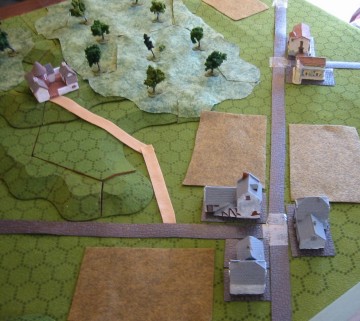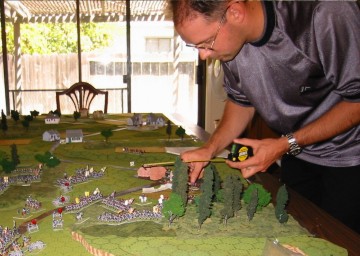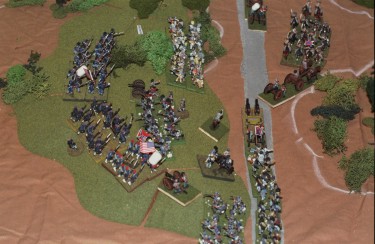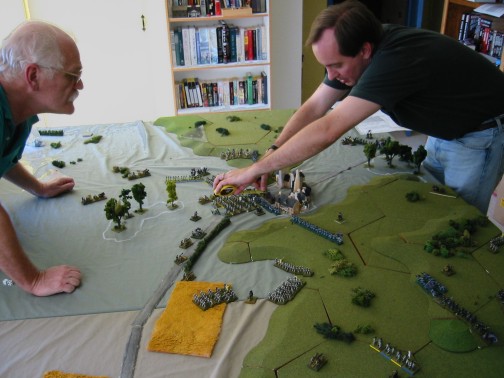
 |

|
|
A French village and chateau in 1870. |

|
|
My cousin Gary Coghlan arranges
French |

|
|
Confederate cannon get
enfilade fire |

|
|
John Gee (left) and Pat
Larkin wage |
One hobby I've taken up in the past twenty years is war gaming. Although I never served in the military—my generation's war was Vietnam and, really, no thank you—I do have a great respect for soldiers, the arts of war, and the political and personal forces that make men and women want to form units and march into battle. Several of my science fiction books have had a military premise, and so late in life I felt I needed to know more about it.
My friend Pat Larkin introduced me to tabletop generalship. Pat has been gaming since he was about 10 years old, and he's much better at it than I am. Interested readers should know Pat collaborated with Larry Bond on the series of techno-thrillers that brought Larry to the New York Times best-seller list. Pat is now writing under his own name and published two techno-novels in the Robert Ludlum tradition, as well as the first book in what we all hope will be a series based on Imperial Rome, The Tribune, in May 2003. Both Pat and Larry have used war games as a way to test their battle scenes for feasibility and realism.
The group I game with does mostly tabletop miniatures from the American Civil War and the Napoleonic era, using variations of the Fire & Fury rule set. This is a simple but realistic way of conducting battles, quite elegant really, that anyone can learn in one or two games. We are also branching out to include European wars of the late 19th century, such as the Franco-Prussian War, as well as ancient Greece and Rome, feudal Japan, and pre-Columbian Mesoamerica using home-grown modifications to the FnF rules.
For anyone who hasn't gamed but is interested, the games are usually based on actual battles with the armies and their starting positions set up in the historical situation. We game with 15 mm and 25 mm miniatures, where a one-inch-square stand with three or four figures on it represents 150 or 200 men, and three or more stands represent a brigade. Units of artillery and cavalry scale up accordingly. It takes about a day for one of us to print up the unit labels and orders of battle, design and set up the terrain, and buy the soft drinks and chips. This is an exciting way to spend a Saturday indoors.
Check out the following links for a recap of some recent games, courtesy of one of our avid players, Warwick Young:
Battle of Gettysburg, Day Two, July 2, 1863, Part 1
Battle of Gettysburg, Day Two, July 2, 1863, Part 2
Battle of Sirte Between British and Italian Naval Forces in the Mediterranean, 1941
Second Battle of Jade Mountain, a Fictitious Campaign in 16th Century Japan
Battle of Lappo Between Russians and Swedes, July 14, 1808
Battle of Eylau in a Fictitious Campaign Between French and Russians in Poland, June 8, 1807
Third Battle of Souk El Arba, November 20, 1942, Part of the Fictitious “Race to Tunisia” Campaign